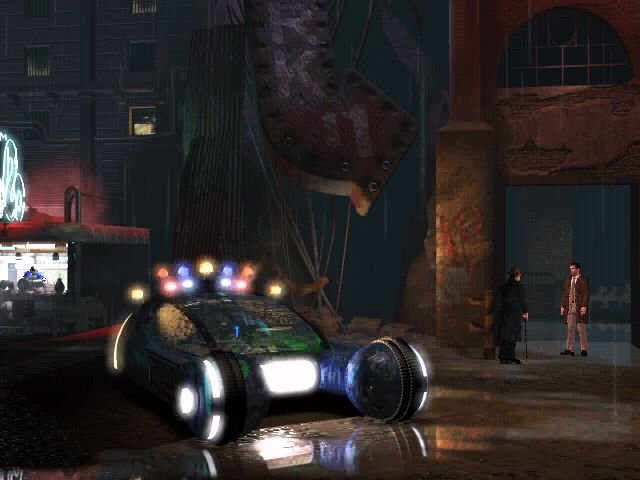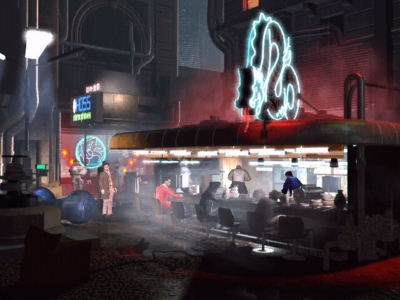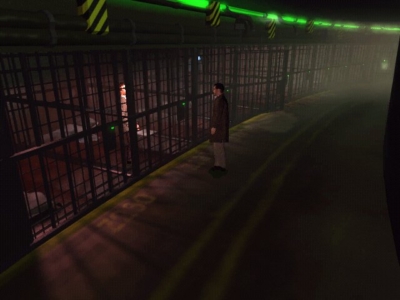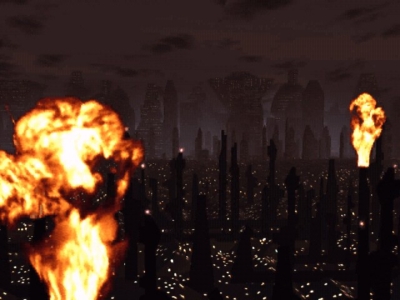
Blade Runner
Written by: Rik
Date posted: January 1, 2004
- Genre: Adventure
- Developed by: Westwood Studios
- Published by: Virgin Interactive
- Year released: 1997
- Our score: 8
Quite a lot of people got excited about the prospect of a Blade Runner game when it was first announced. If nothing else, it represented the first piece of spin-off material from the cult film since its original release, and news that Westwood was to be in charge of the project excited fans and gamers alike; they were arguably at the peak of their success, having conquered the world with Red Alert only a year previously. Anticipation was heightened by the level of secrecy surrounding the game’s development; the gaming press were frequently shown pre-rendered scenes adapted from the film and nothing else. Even when it eventually emerged that the game would be an adventure, very few people actually saw it, allowing Westwood to build expectation further by promising all sorts of innovations that would make Blade Runner very special indeed.
For a start, the graphics were going to be amazing, with all sorts of gimmicky terms (such as ‘real-time lighting and weather’) being bandied about. Then we had all the talk about the revolutionary gameplay – the adventure was going to take place in real-time, characters were going to wander around the game world with their own agenda, and what’s more, the game would decide at random whether they were human or replicant. In theory, we were told, we’d never play the same game twice. It was perhaps inevitable that it failed to live up to expectations. Although reviews were generally favourable, and sales were good, many were disappointed with what they saw as a pretty standard point and clicker with occasionally dreadful graphics.
In fairness, there is some truth in each of these criticisms. While graphically Blade Runner is perfectly alright (in fact in places it’s really quite good), unfortunately for some reason voxels have been used to render all of the in-game characters, and as a result they’re rather blotchy and horrible. So, after the game’s introduction (which recreates the opening scenes of the film) builds the atmosphere impressively, it all comes crashing down the moment your character steps onto the screen. Shame. As for the ‘real-time’ gameplay, suffice to say it’s not all it’s cracked up to be. There is an element of randomness about characters’ whereabouts, but in all other respects it’s very similar to most other adventures. Like every other adventure, you have to do certain things to trigger events that open up more of the game world and allow you to progress.
However, Blade Runner does offer some level of innovation. While you guide the player character, rookie Blade Runner McCoy, through his investigations via the usual point and click method, progress is made by obtaining clues from the dialogue rather than the usual ‘use object on other object’ process of trial and error. Indeed, you can’t actually ‘use’ any of the objects you pick up; they serve only as clues as to what you should do next. The usual inventory is replaced by a database of clues to remind you of the significant information you’ve picked up.
Unlike a lot of adventure games, there is a real sense of your actions having consequences. Ask the wrong question and you might not get the information you’re looking for. Pull out your gun in the wrong place (ahem) and you could find yourself in a lot of trouble. Shoot the wrong person and it might be ‘game over’. And while there are plenty of times where you can tell you are being forced to make a choice, sometimes the progression of the story can be affected by other things, such as your failure to follow up certain clues, or your questioning of a particular character. Okay, so it’s not exactly what we were promised, but there are times when the random elements become apparent and the decision-making aspect of the game really shines through.
As for never playing the same game twice – well, there are 13 different endings, although some are more different than others. Chances are you’ll be able to play through a few times before you’ve seen everything the game has to offer, although it’s really more of a branching storyline than something entirely new each time. Speaking of the story, it’s one of the reasons why Blade Runner is worthy of attention. Without giving too much away, you’re a rookie sent on a routine investigation that leads to something much more sinister, and soon you’re drawn into a tale of intrigue, conspiracy and wondering whether joining the force was such a good idea after all. It doesn’t exactly compare with the brilliance of the film, and some of the characters (especially McCoy, who’s nowhere near as stubbly and miserable as he should be) don’t really seem consistent with the Blade Runner world, but it’s still good stuff.
Plus there’s the fact that it features possibly the best bad-guy in computer game history, Clovis, who begins the game by murdering animals whilst quoting poetry (William Blake, I believe) in a suitably evil voice. The environment is convincingly reconstructed, not always a given when you’re dealing with a licensed product, and the general feeling is of atmospheric authenticity, aided by the presence of the Vangelis soundtrack and cameos from several of the film’s characters (voiced by the original actors).
Some may see Blade Runner as a flawed cash-in with patchy graphics and limited interaction, and to an extent they’ve got a point. But I love it. It’s got the atmosphere of the BR environment, a decent storyline and convincing characters. It’s also different enough from most adventures to boast a level of innovation. Above all, it’s worth playing through more than once in a short space of time, and that’s not something you can say about a lot of adventures. Oh, and it’ll run on a P90. [EDIT: Note to younger readers: a P90 is a kind of ‘computer’ that was considered fairly ‘modestly-powered’ back in the ‘old days’ when this ‘review’ was ‘written’.]






 Posts
Posts